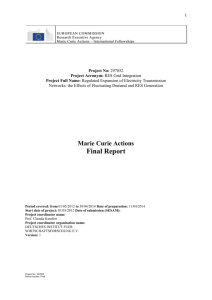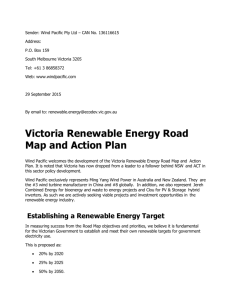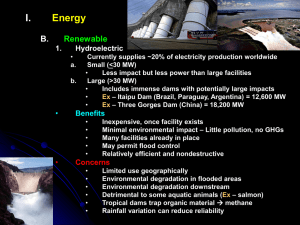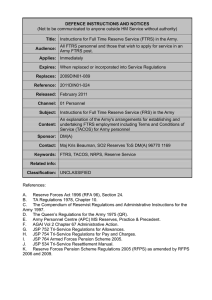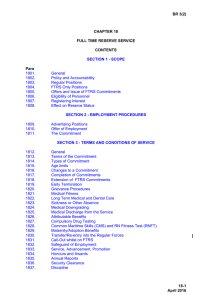periodic1-periodic-report-marie-curie-p-297852-rosellon
advertisement
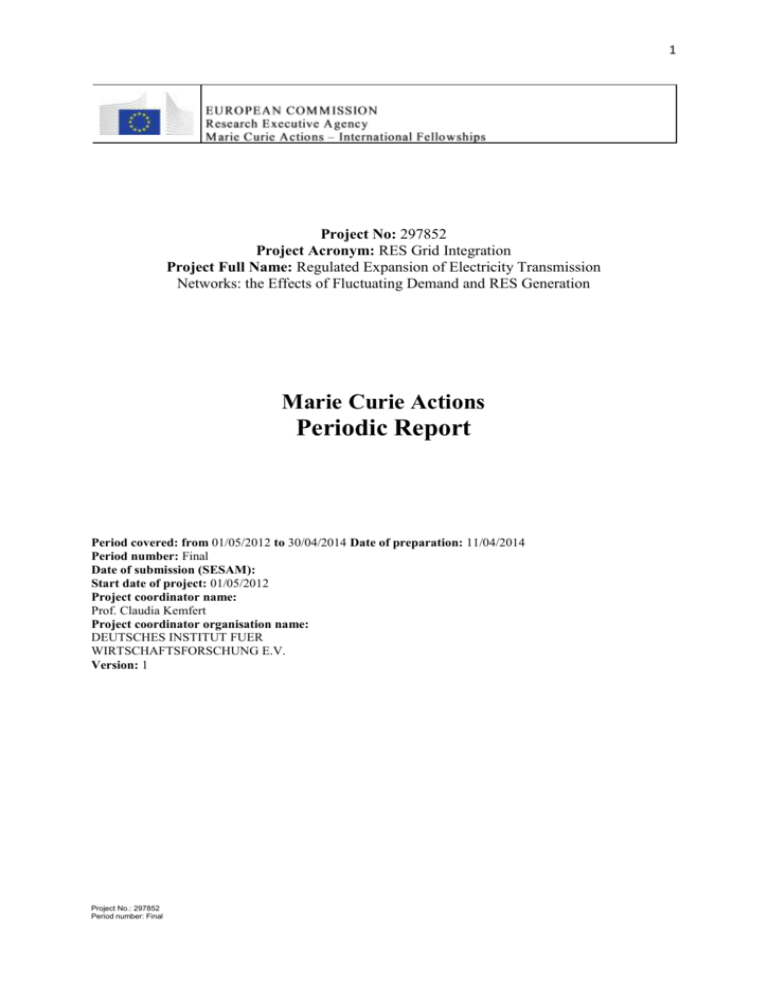
1 Project No: 297852 Project Acronym: RES Grid Integration Project Full Name: Regulated Expansion of Electricity Transmission Networks: the Effects of Fluctuating Demand and RES Generation Marie Curie Actions Periodic Report Period covered: from 01/05/2012 to 30/04/2014 Date of preparation: 11/04/2014 Period number: Final Date of submission (SESAM): Start date of project: 01/05/2012 Project coordinator name: Prof. Claudia Kemfert Project coordinator organisation name: DEUTSCHES INSTITUT FUER WIRTSCHAFTSFORSCHUNG E.V. Version: 1 Project No.: 297852 Period number: Final 2 Periodic Report PROJECT PERIODIC REPORT Grant Agreement number: Project acronym: 297852 RES Grid Integration Project title: Regulated Expansion of Electricity Transmission Networks: the Effects of Fluctuating Demand and RES Generation FP7-MC-IIF Final 01/05/2012 30/04/2014 Prof. Claudia Kemfert DEUTSCHES INSTITUT FUER WIRTSCHAFTSFORSCHUNG E.V. Funding Scheme: Period report: Period covered - start date: Period covered - end date: Name, title and organisation of the scientist in charge of the project's coordinator: Tel: Fax: E-mail: Project website address: Project No.: 297852 Period number: Final +493089789663 +493089789113 ckemfert@diw.de https://www.diw.de/sixcms/detail.php?id=diw_01.c.392447.de 3 DECLARATION BY THE SCIENTIST IN CHARGE I, Prof. Claudia Kemfert, as scientist in charge of the project (297852, RES Grid Integration), hereby confirm that: - The attached periodic report represents an accurate description of the work carried out in this project for this reporting period; - The project: (X) has fully achieved its objectives and technical goals for the period; ( ) has achieved most of its objectives and technical goals for the period with relatively minor deviations; ( ) has failed to achieve critical objectives and/or is not at all on schedule. - The project Website (if applicable) is up to date. - To my best knowledge, the financial statements which are being submitted as part of this report are in line with the actual work carried out and are consistent with the report on the resources used for the project and if applicable with the certificate on financial statement. - The beneficiary, in particular non-profit public bodies, secondary and higher education establishments, research organisations and SMEs, have declared to have verified their legal status. Any changes have been reported under section 6 (Project Management) in accordance with Article II.2.f of the Grant Agreement. Project No.: 297852 Period number: Final 4 1. PUBLISHABLE SUMMARY This section normally should not exceed 2 pages. It shall be of suitable quality to enable direct publication by the REA or the Commission. You may extract this wholly or partially from the website of the project, if suitable, but please ensure that this is set out and formatted so that it can be printed as a stand-alone paper document. Please include: - a summary description of the project objectives, - a description of the work performed since the beginning of the project, - a description of the main results achieved so far, - the expected final results and their potential impact and use (including the socio-economic impact and the wider societal implications of the project so far). You should update this publishable summary at the end of each reporting period. Please include also, as appropriate, diagrams or photographs illustrating and promoting the work of the project, the project logo and relevant contact details. Please ensure that all publishable reports submitted to the REA for publication are of a suitable quality to permit direct publication without any additional editing. By submitting the publishable reports to the REA, you are also certifying that they include no confidential material. The address of the project public website should also be indicated, if applicable. The internet address should be active. Publishable summary: The main goal of this project was to enhance the understanding on how to regulate and expand transmission networks in the light of large-scale renewable-energy-source (RES) integration to electricity systems. The regulation of transmission operation and expansion is widely discussed by regulatory economists. Finding optimal mechanisms is difficult given the specific physical characteristics of electricity networks like negative local externalities due to loop flows obeying the Kirchhoff’s laws. Considering RES-specific issues in network regulation analysis further required to take into account some other complex special objectives and constraints. In particular, the timing of electricity dispatch in RES systems is more frequent and fluctuating than conventional electricity systems, and a renewable-integration process (which substitutes conventional energy with renewable sources) has an effect on the rents from congestion in the network. All these aspects have impacts on transmission investment decisions. This research project then combined theoretical research on the regulation of transmission expansion with applications to different energy systems, and derived policy implications to help decision makers identify appropriate policies. In order to analyze such issues, we initially relied on the HoganRosellon-Vogelsang (HRV) mechanism1 which combines merchant and regulatory structures to promote the expansion of networks. Another approach to transmission expansion would be traditional central planning, which may either be carried out within a vertically integrated utility or by a regulatory authority. Another alternative might be traditional cost-of-service regulation. In contrast, transmission decisions could also be determined in a totally decentralized, non-regulated way. The HRV approach lies among these approaches, combining regulation (via price caps), and market incentives via property rights in electricity investment (financial transmission rights, FTRs). In this project we thus analyzed whether the unique variability and unpredictability characteristics of RES had an effect on transmission expansion decisions within the HRV analytical framework, as well as on investment decisions made under other regulatory regimes. To address these issues, we first analyzed in Schill, Egerer and Rosellón (2014) (second revise-andresubmit status at Journal of Regulatory Economics) the performance of different regulatory approaches for network expansion in the context of realistic demand patterns and fluctuating wind power. We applied these mechanisms to a stylized model of the Western European transmission network. We explicitly included both an hourly time resolution and fluctuating wind power, which substantially increased the real-world applicability of the approach. We solved the model numerically and compared the economic welfare outcomes, and the optimal levels of network expansion. We found that network extension in Western Europe not only increased social welfare due to diminished Hogan, W., J. Rosellón and I. Vogelsang (2010), “Toward a Combined Merchant-Regulatory Mechanism for Electricity Transmission Expansion”, Journal of Regulatory Economics, forthcoming. 1 Project No.: 297852 Period number: Final 5 congestion, but also led to price convergence and therefore a large redistribution of social welfare.2 Comparing different regulatory approaches, we found that the combined merchant-regulatory regime led to welfare outcomes far superior to other modelled alternatives. Further, in Egerer, Rosellón and Schill (2014) (accepted for publication at The Energy Journal) we addressed the rationale for regulation of transmission investment under a renewable integration process characterized by the gradual substitution of conventional power (e.g., coal) with renewable energy sources (e.g., wind). This transition towards a low carbon electricity sector can have temporary or permanent exogenous shocks on transmission requirements. We studied different regulatory regimes for electricity transmission investment in such a context. An independent system operator (ISO) collects nodal-price payments from loads and pays the generators. The difference between these payments is the congestion rent, which is assumed to be transferred to the transmission company (Transco). We modeled then a welfare-maximizing benchmark (WFMax) in which a social planner makes combined decisions on network expansion and dispatch, as well as three different regulatory cases in which we assume the Transco to be unregulated regarding network expansion (NoReg), costregulated (CostReg), or price-cap regulated (HRV). We compared these cases to a baseline without any network expansion. The different regulatory cases were analyzed under different stylized cases of changing technology generation over a timeframe of 20 years. We found that incentive price-cap HRV regulation performs satisfactorily under a renewable-integration process only when appropriate price weights in the price-cap formula are used. Ideally constructed quantity weights, brought back from welfare-optimal steady-state equilibrium, generally restored the beneficial properties of incentive regulatory mechanisms under renewable integration. However, we also searched to more down-toearth weight alternatives. We thus found that, depending on the expected evolution of network congestion, either previous-period (Laspeyres), current-period (Paasche), or average PaascheLaspeyres quantity weights appear to be appropriate choices. In particular, with the proper handling of weights, excessive network investments (that are usual in renewable integration processes) might not be a problem anymore. In the previous studies we found, however, that a combined merchant-regulatory regime for network expansion also leads to a situation in which a substantial portion of the Transco’s income consists of a fixed tariff part. The over-time rebalancing of the two-part tariff carried out by the Transco, so as to expand the network, is such that the fixed fee is considerably higher than the decrease of the variable part. The fixed-tariff part also turns out to be relatively large compared to extension costs, a distributive issue that might be addressed through a proper choice of weight of profits in the welfare criterion. We therefore studied in Herrera and Rosellón (2014) (article in press at Energy Policy) the parameters that a regulator might use to achieve distributive efficiency (a task that had so far not been explicitly analyzed in the economics literature). In particular, we analyzed how different weight parameters affect the distributive characteristics of the incentive price-cap regulation. We found that a regulator's use of ideal (Laspeyres) weights tends to be more beneficial for the Transco (consumers) than for consumers (the Transco). As described above, we performed applications of the models developed in this project to France, Germany, Belgium and the Netherlands. However, we also analysed such models in the context of other industries, such as natural gas (as in Neumann, Rosellón and Weigt, 2014, second revise-andresubmit status at Networks and Spatial Economics) and other countries outside Europe (Ruiz and Rosellón, 2012, published at Energy Policy). It must be mentioned that the above studies were developed under the assumption of existence of a system of nodal prices that provided congestion-rent signals for the network-expansion process. However, during the development of the project, a question arose regarding the feasibility of implementing nodal price systems in markets with a tradition of uniform-pricing schemes (such as Germany). 2 For an Italian case study, Boffa et al. (2010) find that transmission expansion leads to cost savings for consumers. In our paper, we show that removing congestion in the Western European interconnection harms consumers in Germany and France because of increasing spot prices, whereas consumers in Belgium and the Netherlands benefit from network expansion. Project No.: 297852 Period number: Final 6 This motivated us to carry a deep analysis on issues related to implementation of nodal pricing regimes and associated needed financial hedges (financial transmission rights, FTRs). We then firstly put together a series of papers that analyzed these issues in a book published by Springer in its Lecture Note series (Rosellón and Kristiansen, 2013). We were able to attract to this volume some of the most internationally renowned authors in the subject. Subsequently, we wrote a paper (Kunz, Neuhoff and Rosellón, 2014, accepted to be presented net June at the conference on Energy Industry at a Crossroads: Preparing the Low Carbon Future/TIGER FORUM, 2014, Toulouse, France) where we studied the shift from zonal pricing to smaller zones and nodal pricing so as to improve efficiency and security of the electricity-system operation. Such price changes however also shift profits and surplus between generators and consumers, so that individual actors that may lose might oppose such a reform. The initial allocation of FTRs in a newly created nodal-price system has then been one of the most highly disputed parts of market liberalization processes, as in New Zealand and Australia. In Europe there is nowadays a similar challenge, with considerable dimension of high respective shares that are competing for the pie. In our paper we developed a model to explore how an initial free allocation of FTRs at the time of a transition to nodal pricing could be designed so as to avoid revenue or cost shock. We explored how free allocation of FTRs to generators and loads can be used to mitigate distributional impacts. We researched on the metric to determine the proportion of rights to be allocated by the policy maker, and tested the results in a more realistic setting based on the hourly modelling of the German power system at nodal representation. 2. PROJECT OBJECTIVES FOR THE PERIOD Please provide an overview of the project objectives for the reporting period in question, as included in Annex I of the Grant Agreement. These objectives are required so that this report is a stand-alone document. Please include a summary of the recommendations from the previous reviews (if any) and indicate how these have been taken into account. Project objectives for the period: The project´s work plan from May 2012 through April 2014 was as follows: TIME PERIODS MAY 2012 MAY-AUGUST 2012 (FIRST QUARTER) SEPTEMBERDECEMBER 2012 (SECOND QUARTER) JANUARY-APRIL 2013 Start of work package 1: simulation GAMS tests for current HRV model for large-scale RES systems. Data of real-world transmission networks in Europe. Analytical review of bibliography for work packages 2 and 3. Results for work package 1. Writing of article for work package 1. Start of modeling for work package 2: the HRV-RES model. INFRATRAIN 2012 Continuation of modeling work for work package 2: the HRV-RES model Results for work package 2. Start of modeling for work package 3: extension of the HRV-RES model under stochastic RES generation. Interim report International workshop at DIW Writing of an article for work package 2. Results for work package 3: extension of the HRV-RES model under stochastic RES generation. Start of work package 4: simulations of the HRV-RES (model with data from various international transmission grids). Presentation of article of work package 1 and 2 at an international conference (THIRD QUARTER) MARCH-APRIL 2013 MAY-JUNE 2013 MAY-AUGUST 2013 (FOURTH QUARTER) Project No.: 297852 Period number: Final TASKS/MILESTONES Kick off meeting with DIW experts and researchers from Berlin and Potsdam 7 SEPTEMBERDECEMBER 2013 (FIFTH QUARTER) JANUARY-APRIL 2014 (SIXTH QUARTER) APRIL 2014 (e.g. European IAEE conference Dusseldorf, Aug. 18-21) Writing of an article for work package 3. Results of simulations for work package 4. Corrections to articles of work packages 1 and 2 (using comments from presentations at seminars). INFRATRAIN 2013 Writing of an article for work package 4. Presentations at international seminars of article(s) from work packages 3 and 4. Corrections to articles of work packages 3 and 4 (using comments from presentations at seminars). Final report and workshop at DIW Berlin END OF PROJECT The corresponding working packages were: WP1: Testing Regulatory Regimes for Power Transmission Expansion with Fluctuating Demand and Wind Generation (joint with Egerer and Schill): Adequate extension of electricity transmission networks is a key requirement for integrating fluctuating renewable energy sources like wind power into electricity systems. We study the performance of different regulatory approaches for network expansion in the light of realistic demand patterns and fluctuating wind power. In particular, we are interested in the relative performance of a combined merchant-regulatory price-cap mechanism compared to a cost-based and a non-regulated approach. We include both an hourly time resolution and fluctuating wind power, which allows representing residual demand in a very realistic way. This substantially increases the real-world applicability of results compared to previous analyses. We show that a combined merchant-regulatory regulation, which draws on a cap over the two-part tariff of the transmission company, leads to welfare outcomes far superior to the other modeled alternatives. This result proves to be robust over a range of different cases, including such with large amounts of fluctuating wind power. WP2: Towards Optimal Regulation of Transmission Network Investment under Renewable Integration (joint with Egerer and Schill): We analyze various regulatory regimes for electricity transmission investment in the context of a transformation of the power system towards renewable energy. We study distinctive developments of the generation mix with different implications on network congestion, assuming that a shift from conventional power plants towards renewables may go along with exogenous shocks on transmission requirements, which may be either of temporary or permanent nature. We specifically analyze the relative performance of a combined merchant-regulatory price-cap mechanism, a cost-based rule, and a non-regulated approach in dynamic generation settings. Through applications both in a stylized twonode network as well as in a 15-node Northwestern European test case, we find that incentive regulation performs satisfactorily only when appropriate weights are used. While quasi-ideal weights generally restore the beneficial properties that incentive regulatory mechanisms are well-known for in static settings, pure Laspeyres weights may either lead to overinvestment (stranded investments) or delayed investments as compared to the welfare optimum benchmark. Depending on the expected evolution of network congestion, a combination of Laspeyres, Paasche and average Laspeyres-Paasche weights achieve convergence to welfare-optimal investments. Stranded investments could be avoided through proper handling of weights. This analysis motivates further research aimed to characterize optimal regulation for transmission expansion in the context of renewable integration. WP3: Distributional issues on incentive regulatory mechanisms: Distributive implications of incentive regulation on transmission networks have not been studied in the literature. The parameters that a regulator might use to achieve distributive efficiency have so far not been explicitly analyzed. Project No.: 297852 Period number: Final 8 Analyze how different weights affect the distributive characteristics of price-cap regulation in electricity transmission. Results: ideal (Laspeyres) weights tend to be more beneficial for the Transco (consumers) than for consumers (the Transco). WP4: Application of WP2 and WP3 (and/or other regulatory approaches) to various international “multi-country” scenarios, nodal pricing issues and FTRs: Applications of the models developed in this project internationally. Additionally, a shift from zonal pricing to smaller zones and nodal pricing improves efficiency and security of system operation. Resulting price changes do however also shift profits and surplus between and across generation and load. As individual actors can lose, they might oppose any reform. We explore how free allocation of financial transmission rights to generation and load can be used to mitigate the distributional impact. In a three node network the fundamental effects with regard to reference node/hub for FTRs, the share of FTRs to be allocated for free and the metric to determine the proportion of rights allocated to different generation and load are explored. We tested the results in a more realistic setting based on the hourly modelling of the German power system at nodal representation. 3. WORK PROGRESS AND ACHIEVEMENTS DURING THE PERIOD Please provide a concise overview of the progress of the work in line with the structure of Annex I of the Grant Agreement - except project management, which will be reported in section 6. - A summary of progress towards objectives and details for each task; - A summary of the progress of the researcher training activities/transfer of knowledge activities/integration activities (as it applies for the MC action); - Highlight clearly significant results; - If applicable, explain the reasons for deviations from Annex I and their impact on other tasks as well as on available resources and planning; - If applicable, explain the reasons for failing to achieve critical objectives and/or not being on schedule and explain the impact on other tasks as well as on available resources and planning (the explanations should be coherent with the declaration by the scientist in charge) ; - A statement on the use of resources, in particular highlighting and explaining deviations between actual and planned researcher-months in Annex 1 (Description of Work) - If applicable, propose corrective actions. • Work progress and achievements during the period: The progress in each of the WP´s is as follows: 1. The paper of WP1 has been finished and submitted to the Journal of Regulatory Economics (this of course includes data collection on real-world transmission networks as well as literature review). We got an second editorial decision of “revise and resubmit.” We have carried out the suggested referees’ corrections and recently resubmitted: Schill W.P., J. Egerer, and J. Rosellón (2014), “Testing Regulatory Regimes for Power Transmission Expansion with Fluctuating Demand and Wind Generation,” Journal of Regulatory Economics, Springer, ISSN: 0922-680X (Print) 1573-0468 (Online), Revise and Resubmit. 2. With respect to WP2, we completed the final version of two papers. The first paper was presented at the 10th International Conference on the European Energy Market (EEM13) Stockholm, Sweden, May 28-30, 2013, and published as Conference proceeding by the IEEE: Egerer, J., J. Rosellón and W-P. Schill (2014), “Towards Optimal Regulation of Transmission Network Investment under Renewable Integration,” proceedings of the 10th International Conference on the European Energy Market (EEM13), IEEE (Institute of Electrical and Electronics Engineers) Stockholm, Sweden. Project No.: 297852 Period number: Final 9 3. Also with respect to WP2, we published a DIW Discussion Paper (no. 1312), and submitted this paper to The Energy Journal. After the refereeing process, it was finally accepted: Egerer, J., J. Rosellón and W-P. Schill (2014), “Power System Transformation towards Renewables: An Evaluation of Regulatory Approaches for Network Expansion,” The Energy Journal, accepted for publication. 4. On WP3, a paper was accepted at the journal Energy Policy: Herrera, L. and J. Rosellón (2014), “On Distributive Effects of Optimal Regulation for Power Grid Expansion,” Energy Policy, article in press. 5. On WP4, we performed applications of the models developed in this project to France, Germany, Belgium and the Netherlands. However, we also analysed such models in the context of other industries, such as natural gas (as in Neumann, Rosellón and Weigt, 2014, second revise-and-resubmit status at Networks and Spatial Economics) and other countries outside Europe (Ruiz and Rosellón, 2012, published at Energy Policy): Neumann A., J. Rosellón and H. Weigt “Removing Cross-Border Capacity Bottlenecks in the European Natural Gas Market: A Proposed Merchant-Regulatory Mechanism,” Networks and Spatial Economics, Springer Verlag, (second) revise and resubmit. Ruiz, E. And J. Rosellón, 2012,“Transmission Investment in the Peruvian Electricity Market: Theory and Applications,” Energy Policy, 45, pp. 238-245. 6. A Project related book was also published (acknowledging support from the European Union through of a Marie-Curie Fellowship): Rosellón, J. and T. Kristiansen (eds.), Financial Transmission Rights: Analysis, Experiences and Prospects, Lecture Notes in Energy 7, Springer Verlag, 2013, ISBN: 978-1-4471-4786-2 (http://link.springer.com/book/10.1007/978-1-4471-47879/page/1). • A summary of the progress of the researcher training activities/transfer of knowledge activities/integration activities (as it applies for the MC action); 1. At DIW Berlin, I collaborated with Wolf-Peter Schill (Research Associate), Jonas Egerer (PhD student), Daniel Hupmann (PhD Student), and Anne Neumann (Research Associate). Likewise, I collaborated with Professor Hannes Weigt (University of Basel, Switzerland) and Dr. Tarjei Kristiansen (SN Power, Norway). In Mexico, three CIDE Master of Econmics’ student (Ernesto Laguna, Luis Ángel Herrera y César Augusto Bernal) finished their thesess on a topic related to the project. 2. At Enertrain 2013 (October, 2013), I taught a workshop on: “Transmission Expansion and Regulation of Electricity Networks: Theory and Numerical Simulations.” Students from Germany (University of Cologne, TU Dresden, TU Cottbus, Stromnetz Hamburg) and Belgium (KU Leuven). 3. I presented/discussed some of the resulting project’s research in the following events: 4. W.P. Schill J. Egerer, and J. Rosellón (2014), “Testing Regulatory Regimes for Power Transmission Expansion with Fluctuating Demand and Wind Generation,” Journal of Regulatory Economics, (second) revise and resubmit. 5. Egerer, J., J. Rosellón and W-P. Schill (2014), “Towards Optimal Regulation of Transmission Network Investment under Renewable Integration,” proceedings of the 10th International Conference on the European Energy Market (EEM13), IEEE (Institute of Electrical and Electronics Engineers) Stockholm, Sweden. Project No.: 297852 Period number: Final 10 6. Egerer, J., J. Rosellón and W-P. Schill (2014), “Power System Transformation towards Renewables: An Evaluation of Regulatory Approaches for Network Expansion,” The Energy Journal, accepted for publication. 7. Herrera, L. and J. Rosellón (2014), “On Distributive Effects of Optimal Regulation for Power Grid Expansion,” Energy Policy, article in press. 8. Kunz, F., K. Neuhoff and J. Rosellón (2014), “Allocation of FTRs to Ease Transition to Nodal Pricing,” accepted to be presented net June at the Conference on Energy Industry at a Crossroads: Preparing the Low Carbon Future/TIGER FORUM, 2014, Toulouse, France. 9. Neumann A., J. Rosellón and H. Weigt “Removing Cross-Border Capacity Bottlenecks in the European Natural Gas Market: A Proposed Merchant-Regulatory Mechanism,” Networks and Spatial Economics, Springer Verlag, (second) revise and resubmit. 10. Rosellón, J. and T. Kristiansen (eds.), Financial Transmission Rights: Analysis, Experiences and Prospects, Lecture Notes in Energy 7, Springer Verlag, 2013, ISBN: 978-1-4471-4786-2. 11. Ruiz, E. and J. Rosellón (2012),“Transmission Investment in the Peruvian Electricity Market: Theory and Applications,” Energy Policy, 45, pp. 238-245. • Highlight clearly significant results; List of research outputs (as of April 2014): 1. W.P. Schill J. Egerer, and J. Rosellón (2014), “Testing Regulatory Regimes for Power Transmission Expansion with Fluctuating Demand and Wind Generation,” Journal of Regulatory Economics, (second) revise and resubmit. 2. Egerer, J., J. Rosellón and W-P. Schill (2014), “Towards Optimal Regulation of Transmission Network Investment under Renewable Integration,” proceedings of the 10th International Conference on the European Energy Market (EEM13), IEEE (Institute of Electrical and Electronics Engineers) Stockholm, Sweden. 3. Egerer, J., J. Rosellón and W-P. Schill (2014), “Power System Transformation towards Renewables: An Evaluation of Regulatory Approaches for Network Expansion,” The Energy Journal, accepted for publication. 4. Herrera, L. and J. Rosellón (2014), “On Distributive Effects of Optimal Regulation for Power Grid Expansion,” Energy Policy, article in press. 5. Kunz, F., K. Neuhoff and J. Rosellón (2014), “Allocation of FTRs to Ease Transition to Nodal Pricing,” accepted to be presented net June at the Conference on Energy Industry at a Crossroads: Preparing the Low Carbon Future/TIGER FORUM, 2014, Toulouse, France. 6. Neumann A., J. Rosellón and H. Weigt “Removing Cross-Border Capacity Bottlenecks in the European Natural Gas Market: A Proposed Merchant-Regulatory Mechanism,” Networks and Spatial Economics, Springer Verlag, (second) revise and resubmit. 7. Rosellón, J. and T. Kristiansen (eds.), Financial Transmission Rights: Analysis, Experiences and Prospects, Lecture Notes in Energy 7, Springer Verlag, 2013, ISBN: 978-1-4471-4786-2. 8. Ruiz, E. and J. Rosellón (2012),“Transmission Investment in the Peruvian Electricity Market: Theory and Applications,” Energy Policy, 45, pp. 238-245. • If applicable, explain the reasons for deviations from Annex I and their impact on other tasks as well as on available resources and planning; o Not applicable Project No.: 297852 Period number: Final 11 • If applicable, explain the reasons for failing to achieve critical objectives and/or not being on schedule and explain the impact on other tasks as well as on available resources and planning (the explanations should be coherent with the declaration by the project coordinator) ; o Not applicable • A statement on the use of resources, in particular highlighting and explaining deviations between actual and planned researcher-months in Annex 1 (Description of Work) o o o A laptop was purchased for the beneficiary. Resources to attend the 10th International Conference on the European Energy Market (EEM13), Stockholm, Sweden, May 28-30, 2013. Resources to attend the 13th European IAEE Conference 2013, “Towards Optimal Regulation of Transmission Network Investment under Renewable Integration,” Düsseldorf, Germany, August 18-21, 2013. • If applicable, propose corrective actions. o Not applicable 4. ADDITIONAL INFORMATION Comments: It must be mentioned that the studies in this project were developed under the assumption of existence of a system of nodal prices that provided congestion-rent signals for the electricity-network expansion processes. However, during the development of the project, a question arose regarding the feasibility of implementing nodal price systems in markets with a tradition of uniform-pricing schemes (such as Germany). This motivated us to carry a deep analysis on issues related to implementation of nodal pricing regimes and associated needed financial hedges (financial transmission rights, FTRs). We then firstly put together a series of papers that analyzed these issues in a book published by Springer in its Lecture Note series (Rosellón and Kristiansen, 2013). We were able to attract to this volume some of the most internationally renowned authors in the subject. Subsequently, we wrote a paper (Kunz, Neuhoff and Rosellón, 2014) where we developed a model to explore how an initial free allocation of FTRs at the time of a transition to nodal pricing could be designed so as to avoid revenue or cost shock, and mitigate distributional impacts. We found the metrics to determine the proportion of rights to be allocated by a policy maker, and tested the results in a more realistic setting based on the hourly modelling of the German power system at nodal representation. It should alos be pointed out that the results of the research carried out in the Berlin Conference on Electricity Economics (2013) (Modeling and Policy in the Energy Transformation – Germany, Europe, and Beyond), and in the EnerTrain Autumn School (2013). 5. DISSEMINATION ACTIVITIES Use this section to summarise all dissemination activities executed during the reporting period as well as activities planned for next period. Dissemination activities: o o Project No.: 297852 Period number: Final Conference on Energy Industry at a Crossroads: Preparing the Low Carbon Future/TIGER FORUM 2014, “Allocation of FTRs to Ease Transition to Nodal Pricing (joint with Friedrich Kunz and Karsten Neuhoff),” University of Toulouse, Toulouse, France, June 5-6, France. 28th Latin American Meeting of the Econometric Society: LAMES, “Testing Regulatory Regimes for Power Transmission Expansion with Fluctuating Demand and 12 o o o o o o o o o o Wind Generation (joint with Wolf-Peter Schill, and Jonas Egerer),” Mexico D.F., Mexico, 31.10.2013 - 02.11.2013 Berlin Conference on Electricity Economics (2013): Modeling and Policy in the Energy Transformation – Germany, Europe, and Beyond, presentation of the book: Rosellón, J. and T. Kristiansen (eds.), (2013); Financial Transmission Rights: Analysis, Experiences and Prospects, Lecture Notes in Energy 7, Springer Verlag, ISBN: 978-1-4471-4786-2 , Berlin, Germany, October 10th, 2013. Berlin Conference on Electricity Economics (2013): Modeling and Policy in the Energy Transformation – Germany, Europe, and Beyond, "Power System Transformation towards Renewables: Effects on Optimal Network Expansion", Berlin, Germany, October 10th, 2013. EnerTrain Autumn School (2013), Transmission Expansion and Regulation of Electricity Networks: Theory and Numerical Simulations, Juan Rosellón, Coordinated by the German Institute for Economic Research (DIW Berlin) and the Workgroup for Economic and Infrastructure Policy (WIP) at TU Berlin, Berlin, 07.10.2013 11.10.2013. 13th European IAEE Conference 2013, “Towards Optimal Regulation of Transmission Network Investment under Renewable Integration,” Düsseldorf, Germany, August 18-21, 2013. 10th International Conference on the European Energy Market (EEM13), “Towards Optimal Regulation of Transmission Network Investment under Renewable Integration,” Stockholm, Sweden, May 28-30, 2013. 10th International Conference on the European Energy Market (EEM13), “Towards Optimal Regulation of Transmission Network Investment under Renewable Integration,” Stockholm, Sweden, May 28-30, 2013. National Congress on Basic Scientific Research (Congreso Nacional de Investigación Científica Básica), “An Incentive Mechanism for Electricity Transmission Expansion,” Mexican National Science Foundation (Conacyt), Cancún, Mexico, November 21-23, 2012. Sustainability Cluster-Brown Bag Seminar, “Testing Regulatory Regimes for Power Transmission Expansion under RES Grid Integration,” German Institute for Economic Research (DIW Berlin), Berlín, Alemania, 24 October, 2012 (“kick-off” meeting). Conference on „Modellgestützte Analysen für die Strommarktgestaltung zur Integration erneuerbarer Energien im Rahmen der Energiewende,“ German Institute for Economic Research (DIW Berlin), Berlín, Alemania, 12 October, 2012. INFRATRAIN, 2012, DIW Berlin. 6. PROJECT MANAGEMENT Please use this section to summarise management activities during the period: - Project planning and status - from management point of view; - Problems which have occurred and how they were solved or envisaged solutions; - Changes to the legal status of any of the beneficiaries, in particular, SME status; - Impact of possible deviations from the planned milestones and deliverables, if any; - Development of the project website (if applicable); - Gender issues; Ethical issues; - Justification of subcontracting (if applicable); - Justification of real costs (management costs); - Other For 2007 and 2008 calls a detailed description of costs related to management and overhead is requested Project management: Project planning and status – from management point of view; o The project took place according to the planned milestones and deliverables. Project No.: 297852 Period number: Final 13 • Problems which have occurred and how they were solved or envisaged solutions; o Not applicable • Changes to the legal status of any of the beneficiaries, in particular, SME status; o Not applicable • Impact of possible deviations from the planned milestones and deliverables, if any; o Not applicable • Development of the project website (if applicable); o Not applicable • Gender issues; Ethical issues; o Not applicable Project No.: 297852 Period number: Final 14 Attachments The content of this report has been approved by the researcher and the scientist in charge assigned to this project. The electronic submission of this report shall replace their signatures. This declaration was visaed (signed) electronically by Marijke JANSSEN (ECAS user name njanssma) on Project No.: 297852 Period number: Final
